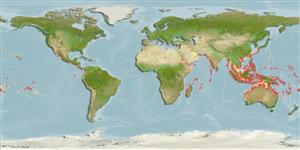Common names from other countries
Environment: milieu / climate zone / depth range / distribution range
экология
морской ассоциированный с рифами; пределы глубины 0 - 48 m (Ref. 58302), usually ? - 10 m (Ref. 30404). Tropical; 32°N - 33°S, 27°E - 76°W
Indo-Pacific: Red Sea and East Africa (Ref. 33390) and Persian Gulf (Ref. 68964) to the Society Islands, north to southern Japan and the Hawaiian Islands, south to Lord Howe Island; throughout Micronesia. Eastern Central Pacific: southern Baja California, Mexico and from Costa Rica to northern Colombia (Ref. 9324). Also found in Southeast Atlantic.
Size / Вес / Возраст
Maturity: Lm ? range ? - ? cm
Max length : 100.0 cm TL самец/пол неопределен; (Ref. 48635); common length : 50.0 cm TL самец/пол неопределен; (Ref. 3258)
колючие лучи спинного плавника (общее число) : 0; членистые (мягкие) лучи спинного плавника (общее число) : 0; колючие лучи анального плавника: 0; членистые (мягкие) лучи анального плавника: 0; позвонки: 119 - 126. Body white with 2 rows of large dendritic black blotches; black spots between blotches become irregularly linear with age. Yellow eyes (Ref. 48635).
Found between rocks and corals of intertidal reef flats, also in shallow lagoon and seaward reefs to depths of at least 10 m (Ref. 9710, 58302). Benthic (Ref. 58302). Nocturnal (Ref. 68964). Feed mainly on crustaceans. Protogynous hermaphroditism unconfirmed for this species (Ref. 84746). Safely kept with small aquarium fishes (Ref. 9710). Solitary, seen usually in the open or with only head exposed (Ref 90102). Minimum depth reported taken from Ref. 86942.
Life cycle and mating behavior
Maturities | размножение | Spawnings | Egg(s) | Fecundities | личинки
Protogyny unconfirmed (Ref. 84746).
Chen, H.-M., K.-T. Shao and C.T. Chen, 1994. A review of the muraenid eels (Family Muraenidae) from Taiwan with descriptions of twelve new records. Zool. Stud. 33(1):44-64. (Ref. 6934)
Статус Красного Списка МСОП (Ref. 130435)
CITES (Ref. 128078)
Not Evaluated
Угроза для людей
Harmless
Использование человеком
рыболовство: не имеет хозяйственного значения; аквариум: коммерческий
дополнительная информация
инструменты
Специальные отчеты
Скачать в формате XML
ресурсы в Интернет
Estimates based on models
Preferred temperature (Ref.
115969): 24.9 - 29.3, mean 28.4 (based on 3674 cells).
Phylogenetic diversity index (Ref.
82804): PD
50 = 0.5005 [Uniqueness, from 0.5 = low to 2.0 = high].
Bayesian length-weight: a=0.00034 (0.00022 - 0.00052), b=3.31 (3.19 - 3.43), in cm Total Length, based on LWR estimates for this species & (Sub)family-body (Ref.
93245).
Trophic level (Ref.
69278): 4.2 ±0.71 se; based on food items.
устойчивость к внешним воздействиям (Ref.
120179): низкий, минимальное время удвоения популяции 4.5-14 лет (Preliminary K or Fecundity.).
Fishing Vulnerability (Ref.
59153): High vulnerability (60 of 100).
